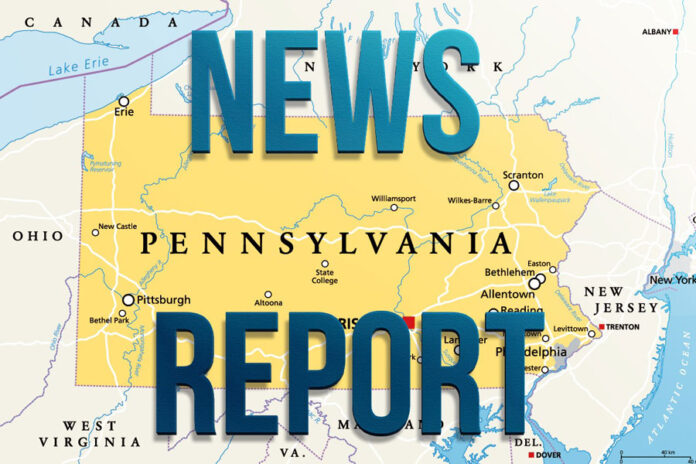Altoona Mirror. April 18, 2024
Editorial: Overdoses at prison troubling
The April 12 Mirror article “Five Blair prison inmates overdose” should have done more than raise the eyebrows of those reading it.
The article should have been an incentive for those readers to ponder what more can be done to deter smuggling into the prison items that are forbidden — items often referred to as contraband.
Some of those readers probably wondered what the Pennsylvania Legislature might be able to do, and whether the legislative delegations of Blair and surrounding counties would be able to build support among their other state governmental colleagues in Harrisburg for a tougher stance against such crime.
But first a recap of what led to the April 12 article and the subsequent concern, anger and inconvenience — yes, inconvenience — for which the incident was no doubt responsible:
As the article reported, five inmates of the Blair County lockup had to be transported for hospital treatment on the night of April 10 after they were found to be overdosing on what initially was an undetermined substance but later was suspected to be fentanyl and “some sort of liquid.”
Ambulance crews and officers from Hollidaysburg and Logan Township plus personnel from the county sheriff’s department were among the responders to a report of overdosing inmates on the county prison’s E-block.
Upon those responders’ arrival, they ascertained that, yes, a total of five inmates were displaying overdose symptoms and the decision was made almost immediately for all five to be checked at Altoona Hospital.
One of the five was described as nonresponsive, and that inmate ended up being admitted to the hospital. After treatment, the other four were returned to the prison.
All of the inmates were given the same quality of treatment as any other human being needing the hospital’s services, although some people waiting in the hospital for treatment that night might not have appreciated having to wait longer while those irresponsible individuals supposedly paying their debt to society were moved, presumably, to the front of the treatment line, or nearly so.
It was a situation unfair to the non-inmates, but it was a situation that was necessary nonetheless.
Nor was the situation fair to responders whose well-being or lives were placed in danger while rushing to the prison initially and then during transport of the inmates to Altoona Hospital quickly for emergency care.
Nevertheless, that is not all that needs to be reflected upon in regard to the April 10 situation.
For example, there is that individual “out there” who delivered the illegal substances to the prison — illegally — and who deserves to be arrested and punished.
But do the state’s current sentencing guidelines address that person’s crime adequately? It is reasonable to think maybe not.
What is being suggested here is that there be a state government level examination of criminal statutes related to contraband delivery to prison inmates, and where it is deemed that changes should be made, make them.
Obviously, the person who delivered the illegal substances to the five inmates in question on April 10 was not deterred by fears of getting caught — and with what punishment might be in store, if he or she were apprehended.
That weak — or lack of — concern must be reversed, and the General Assembly holds the power to accomplish it, if it commits itself to doing it.
___
Pittsburgh Post-Gazette. April 18, 2024
Editorial: Shapiro energy plan keeps Pa. interests front and center
Gov. Josh Shapiro’s newly released energy plans for Pennsylvania aren’t perfect, and certainly won’t satisfy everyone. There are aspects that have attracted scorn, such as including speculative energy technologies like nuclear fusion in the state’s alternative energy portfolio standards. And there are aspects that remain unsettled, including just where the proposed cap on carbon emissions in the energy sector would be set.
Altogether, however, Mr. Shapiro should be applauded for bringing a wide variety of stakeholders to the table and for generating a plan specific to Pennsylvania’s regionally unique status as an energy exporter. Republican legislators and industry interests should stop blasting the plan, largely on ideological rather than practical grounds, and join Mr. Shapiro at the negotiating table to hammer out a compromise that will achieve the dual goals of expanding energy employment in the commonwealth while cutting back on climate-warming emissions.
Solving RGGI
The Shapiro administration’s proposed Pennsylvania Climate Emissions Reduction Act (PACER) is an attempt to resolve the thorny question of Pennsylvania’s participation in the Regional Greenhouse Gas Initiative (RGGI, pronounced “Reggie”). RGGI is a consortium of 11 states from Maine to Virginia that sets a shared cap on carbon emissions from power generation, and distributes carbon allowances that energy companies must buy at auction and can subsequently trade — hence the shorthand “cap and trade.”
RGGI was a political flashpoint during the Tom Wolf administration, both due to the program itself and due to the manner in which the administration pursued it. Unable to get RGGI through a Republican-controlled legislature, Mr. Wolf ultimately brought the commonwealth into the consortium by executive order. The Commonwealth Court ultimately ruled that RGGI was an unconstitutional tax imposed by the executive, and the matter is currently pending before the state Supreme Court.
Mr. Shapiro set out to create an energy plan that could avoid the RGGI mess altogether, and hopefully pass through the GOP-led Senate. Among the differences between PACER and RGGI, one stands out: Pennsylvania would set its own cap and manage its own market as an energy exporter, independent of nearly a dozen energy importers.
Pennsylvania first
As a matter of energy production, Pennsylvania is the Saudi Arabia of the northeast U.S., with 35% of energy generated here being exported out of state. This means that consumers in other states would bear 35% of the increase in energy costs created by the cap-and-trade system.
While the Post-Gazette Editorial Board has supported the state’s entering RGGI in the past, and would do so now for its essential climate change mitigation efforts, RGGI was always an awkward fit for a net energy exporter like Pennsylvania. That’s because the energy-exporting commonwealth would be dependent on energy-importing states to determine the carbon cap, the costs of which would be disproportionately borne by Pennsylvania.
PACER would maintain the cap-and-trade scheme while keeping control of the all-important cap within Pennsylvania. This is a key distinction that Republicans and industry interests elide when they describe the Shapiro plan as “backdoor RGGI.”
How exactly the cap would be determined, however, remains unsettled. RGGI has automatic annual decreases in the the cap punctuated by occasional “program reviews” joined by all the participating states. California, the only state with its own cap-and-trade program, pegged the cap to 1990 emissions, and then lowered it 3% annually from 2007 to 2020, and 5% thereafter. The Shapiro administration has promised to convene all stakeholders invested in the cap: One way to appease Republicans may be to ensure substantial energy industry participation in the rulemaking process.
The slow decline of the cap, however, must be non-negotiable. The point is to wean Pennsylvania off carbon-emitting energy production, but on a timeline suitable to Pennsylvania.
PRESSing forward
A complement to PACER in the Shapiro plan is the Pennsylvania Reliable Energy Sustainability Standard (PRESS), which would adjust the commonwealth’s pie chart of power generation sources to require 50% clean or near-clean energy sources by 2035. Increasing the clean energy share is meant to spur investment (and therefore job creation) in these industries, but moving too fast could also threaten the reliability of the electrical grid.
The administration should be open to negotiations with Republicans on the precise division of the pie chart: Ultimately the carbon cap will drive the energy transition more than the PRESS guidelines.
A good deal
Opposition to the Shapiro plan is largely partisan and ideological, not realistic or practical. Take the argument that the cap-and-trade system would be a “tax” on consumer energy bills.
PACER would return 70% of the proceeds from the carbon allowance auction to direct energy refunds for consumers — a higher figure than other RGGI states — with the other 30% set aside for low-income rebates, fossil fuel modernization projects, home energy efficiency programs and other green initiatives. Remember that only 65% of Pennsylvania energy is consumed here: That means that Keystone consumers would bear 65% of the costs, and receive 70% of the benefits. And that means lower energy bills, not higher.
As for concerns about lost jobs, the Shapiro plan engaged organized labor, and has the support of the unions whose members build and maintain energy infrastructure. These trade unions are interested in one thing: well-paying jobs. Many opposed RGGI because they felt the climate gains weren’t worth the potential cost in jobs, and they believe this plan is different. On this, the GOP should recognize its shared interests with the membership of the trade unions.
Clearly at least some elected Republicans believe nothing at all should be done to mitigate the state’s carbon emissions. We believe the party’s Senate leadership knows better, and that a compromise is possible. PACER and PRESS are excellent starting points for a deal that can ratchet down the commonwealth’s emissions while protecting and creating jobs — all while maintaining Pennsylvania’s competitiveness and independence.






















